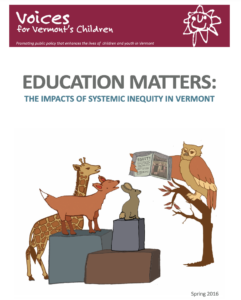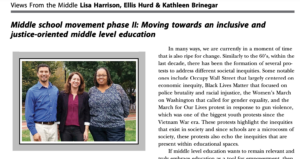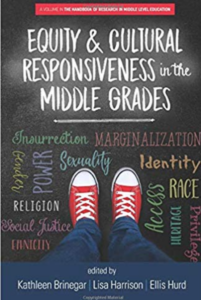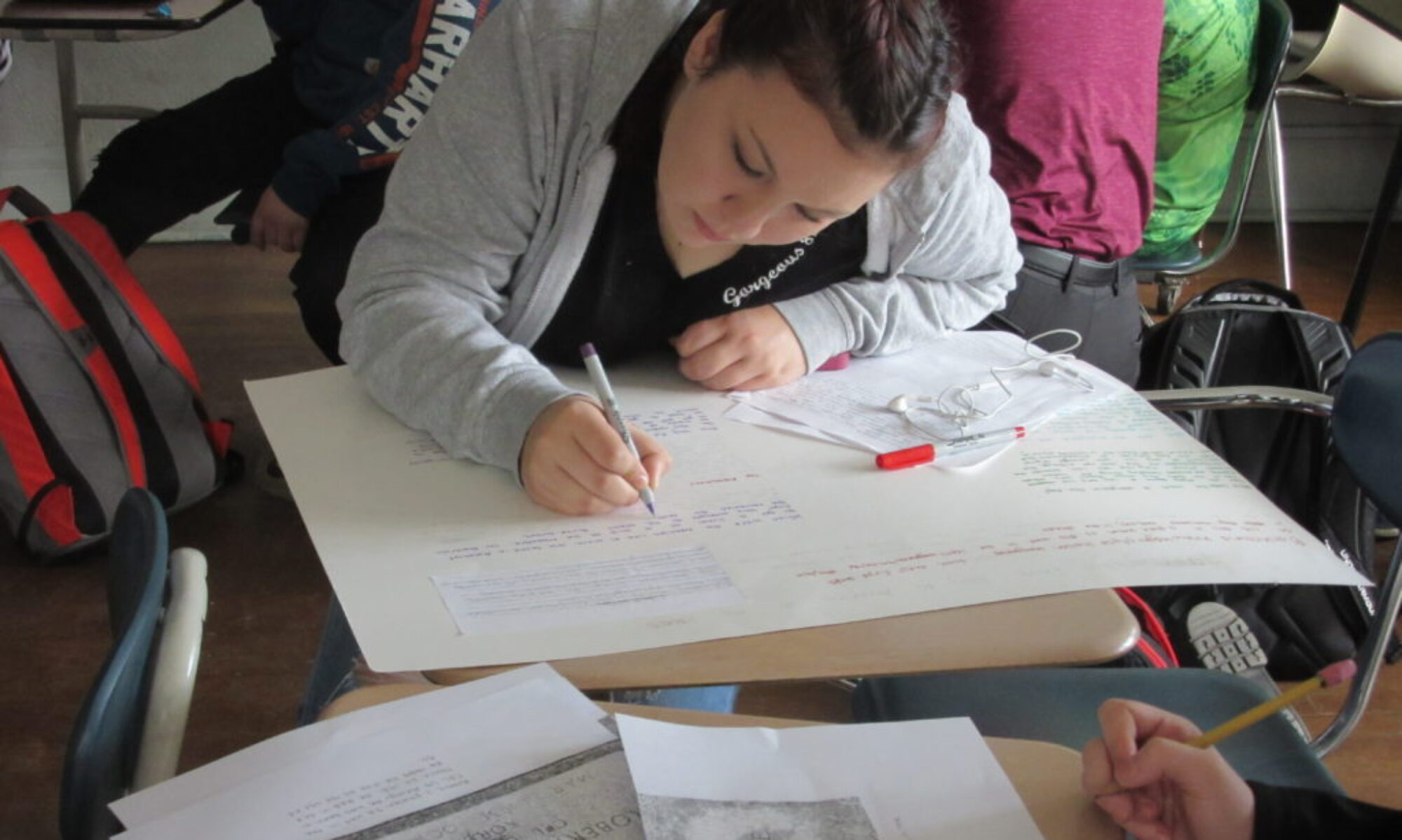The middle school movement has been a powerful force for positive change. It’s rooted in progressive education, with special attention to the developmental needs of young adolescents.
In Vermont, we are ahead of most other states in implementing middle school systems and associated student-centered practices. That’s a good thing. Relative newcomers to this place, like me, should give big props to so many educators here who have championed innovative learning environments.
Yet there is a flaw at the heart of the middle school movement.
In the fervor to be maximally responsive to the developmental needs of young adolescents, it has downplayed the individual identities and complex contexts of our students.
For middle school educators who look to the movement for guidance, we may be missing the trees for the forest. And this is causing us to miss out on fully apprehending the strengths of our students. Or giving them them the guidance they need to meet challenges and to thrive. For middle school movement equity, we must strive to combine the developmental with the cultural to create an approach that is more authentically personal.
Engagement for whom?
While there is consensus that student engagement is paramount, we can’t truly put students at the center without being very specific about who they are.
In an editorial titled “Engagement for Whom?” in AMLE’s Middle School Journal, Lisa Harrison, Ellis Hurd, and (Vermont’s own) Kathleen Brinegar posed this key question. As a team of editors, they asked us to support every young adolescent “by shifting the conversation from focusing on middle school organizational structures in general, to contextualizing them within broader social, cultural, and political contexts.”
If we look at the Vermont context, we see glaring inequalities. As catalogued in the report Education Matters: The Impact of Systemic Inequity by Voices for Vermont’s Children:
- The school-to-prison pipeline is flowing – Students with disabilities, Black students, and Native American students were suspended up to three times as often as their counterparts. They were also more likely to be referred to law enforcement by school staff.
- Opportunity to learn gaps persist – The average standardized test score gaps are 18 percent by race and 25 percent by income. Schools graduate marginalized students on time at significantly lower rates.
- Schools are not safe spaces for too many students – Students of color and students who identify as Lesbian, Gay, Bisexual, and Transgender (LGBTQ) are two to four times as likely to miss school because they don’t feel safe there.
In middle schools specifically, we continue to have too many students from marginalized backgrounds who are don’t feel valued or like they belong. This is despite the fact that structures such as advisory programs and teaming are fairly widespread.
We simply can’t assume that by changing school structures and improving instruction generally, we will achieve equity.

Beyond generic engagement
In the past I believed that if we could raise the overall quality of our systems and instruction, that equity would take care of itself. For example, take my blog post from 2016, Equity begins with engagement. I argued that educators could tackle systemic inequality by “lighting a spark” in every student. In effect I pointed to personalized learning as a panacea that could battle inequity in all its forms.
Now I recognize that personalized learning is limited if it doesn’t focus on dismantling oppression.
And that means we need to do the hard work of truly centering the identity of each of our students, in all their complexity and cultural depth.
Middle school movement equity at the moment isn’t as helpful as it should be in reorienting us to active anti-oppression. But there are a growing number of scholars and educators trying to change that.
“Middle School Movement Phase II”
The editors of the Middle School Journal have called publicly for the middle school movement to shift its focus to equity.
“If middle level education wants to remain relevant and truly embrace education as a tool for empowerment, then we must focus on researching and sharing middle level practices that work to disrupt the status quo. This includes racism, classism, xenophobia, religious discrimination, heterosexism, ageism and other forms of oppressive structures within society.”
I interpreted this as a provocative challenge: if we are all about equity, then let’s fight for it directly. We don’t need to rely on entry points like engagement. Our middle school movement equity needs to actively promote equity both instructionally and institutionally.
Just as we must avoid over-relying on engagement as an entry point, we must come to terms with the limits of developmentalism. The middle school movement’s focus on early adolescence as a stage of life may have caused us to lose sight of knowing the individual students in front of us.
This is why the Middle School Journal editors call for a course correction. They argue that in Phase II of the movement:
“While we need to celebrate and be responsive to the unique characteristics of early adolescence, we cannot do so without recognizing and celebrating the unique identities and lived experiences of every young adolescent who enters our schools. When we do, we are recognizing that our job as middle grades educators is to empower each student to transform themselves. Such empowerment has the potential for youth to become critically conscious, which in turn supports their development as producers of knowledge and transformers of society.”
Let’s get radical
Critical consciousness is an ambitious goal.
In Critical consciousness: The key to student achievement, Aaliyah El-Amin and others describe critical consciousness as “the ability to recognize and analyze systems of inequality and the commitment to take action against these systems.”
Paulo Freire popularized critical consciousness 50 years ago. It is a key component of many asset-based pedagogies, including Culturally Relevant Teaching, developed by Gloria Ladson-Billings.
Yet some people may be alarmed by the idea that middle school education would seek to teach students to dismantle systemic oppression. This is why the push for Phase II is a big deal. It is unabashedly anti-oppressive. Though it is not partisan, it is political in the sense that it seeks to redistribute power to fully support students from marginalized communities.
Getting serious about middle school movement equity will indeed challenge the status quo. And that’s never an easy fight.

Revisiting our beliefs
The middle school movement intended to challenge the status quo from the beginning. When This We Believe dropped in 1982, it represented forceful advocacy for ideas that had been swirling around for at least a decade. The document challenged the junior high school model that was dominant at the time. What young adolescents needed were radically different and very much in line with the values of progressive education: lots of socialization, student choice and voice, and real world relevance.
I have personally found This We Believe incredibly helpful and have used aspects of it to drive professional learning numerous times. Yet recently I have become more acutely aware of flaws in this foundational document.
It’s time to talk about race
Let’s consider how race is addressed in This We Believe. And just as importantly, how race is not addressed.
Starting with a race-focused critical lens is important and instructive for many reasons. First, racism is arguably the primary oppressive force in this country. Second, studying the way racism operates and how to fight it informs all other anti-oppression efforts. And third, racism is really difficult to talk and think about. So if we don’t start with race then we are unlikely to go there naturally.
Using critical race theory, Christopher Busey systematically analyzed what is said and unsaid about race in This We Believe. He concluded that the text upholds two problematic narratives:
- There is no story about race.
- Racial difference as deficit.
For the most part, race is not an issue for young adolescents. But when it is, it’s a problem.
“The heartbeat of racism is denial”
The title of Ibram X. Kendi’s opinion piece in the New York Times is applicable here.
Ignoring race doesn’t make racism go away. Quite the opposite. Per Busey: “This We Believe’s colorblind ideology is complicit in constructing a racial reality of disproportionate discipline, culturally desynchronized curriculum, and hostile learning environments for early adolescent children of color.”
Color-evasiveness (often referred to as colorblindness) is problematic and has demonstrably racist impacts. Race impacts everyone, even if some white people don’t realize it or perceive impact in their own lives. When somebody says “I don’t see race,” they are not acknowledging the racial realities of people of color. When teaching students of color, color-evasiveness is a barrier to curricular connection and harmful to relationships.
Alternatively, a deeper understanding of how race operates allows us to be critical of the systems of inequity in which we participate. We may be able to start to understand how schools privilege certain ways of acting and learning that unnecessarily disadvantage many students. And we may be able to take steps to move from deficit- to asset-oriented mindsets that help middle schools become places where all students can thrive.
Busey offered three belief statements in opposition to This We Believe:
- We believe race is central to identity development.
- We believe smartness is a racialized construct; racial difference is not a cognitive deficiency.
- We believe race matters in creating positive school environments and subsequently, socio-emotional and psychological development.
These crystal clear belief statements directly address racial equity. If we don’t say this stuff out loud and commit, equity won’t happen organically. Busey’s statements leave less room for accidentally perpetuating racial inequity.
It’s about impact, not intent
Racism and other oppressive systems do not require overtly bad intentions. Impact is what matters. The authors of This We Believe, while they were mostly white men, meant for the document to align with equity. But as Stephanie P. Jones put it in her recent article Ending Curriculum Violence,
“The notion that a curriculum writer’s or teacher’s intention matters misses the point: Intentionality is not a prerequisite for harmful teaching. Intentionality is also not a prerequisite for racism.”
In that spirit, I must recognize that my reliance on the ideas birthed in This We Believe has made me complicit with racism and oppression.
It hurts me to say this.
But once I’ve recognized this as a problem I need to put my energy into fixing it.
Beyond developmentalism
Seeing our students as young adolescents is not enough to be responsive to their needs. We must seek to understand race and other social forces that impact their lives and their learning.
As Bettina Love put it even more pointedly in her Education Week commentary Dear White Teachers: You Can’t Love Your Black Students if You Don’t Know Them:
“Let me be clear: I do not think White teachers enter the profession wanting to harm children of color, but they will hurt a child whose culture is viewed as an afterthought.”
We must center the aspects of identity that are most important to each student. In some cases that is race. In other cases and moments it may be gender, class, sexuality, and the intersections thereof.
Simply put:
“Middle level educators must realize that culture and identity often matter more than age in shaping the experience of young adolescents.”
The above statement appears in Chapter 1 of a recently published book called Equity & Cultural Responsiveness in the Middle Grades (edited by Brinegar, Harrison, and Hurd). It compiles research from twenty some scholars delving into the themes of this blog post.
This straightforward statement represents a call for recalculating the weight of developmentalism in the middle school equation.

Where does cultural responsiveness (or the lack thereof) play out in middle schools?
Consider how important considerations have been left out of the mainstream discussion of the three major areas of adolescent development.
- Physical Development
- Emphasizes traditional Eurocentric standards of beauty
- Emphasizes heteronormative understandings of gender and sexuality
- Minimizes the impact of food and housing insecurity on physical development
- Cognitive Development
- Lacks culturally responsive pedagogies
- Fails to recognize the limitations of monolingualism and benefits of multilingualism
- Overrepresents culturally diverse students in special education
- Social-emotional Development
- Downplays or ignores the influence of cultural identity on belonging
- Uses predominantly color-evasive approaches, particularly by white teachers
- Fails to pay attention to the importance of creating affirming spaces for students with historically devalued and marginalized identities
If we aren’t sufficiently aware of the social-historical forces operating on layers of identity, we are in danger of seeing differences as deficits.
We are more likely to see deviations as bad or abnormal when adolescent development is framed in general terms. We need to connect developmental and cultural responsiveness.
And the first best thing we can do is to broaden our understanding of identity. We need to deepen our understanding of students so that we see can clearly see their assets. The middle school movement helped shine a spotlight on the positive potential of young adolescence. Now we need to commit to being equally responsive to cultural and social aspects of identity.
The way forward
If we are willing to do the work, we can draw on any number of well established asset-based approaches. These are deep pedagogies that require attention to self and systems.
… engaging in social justice work requires the acknowledgement that equity frameworks such as culturally relevant pedagogy (Ladson-Billings, 1995; Ladson-Billings, 2014), cultural responsiveness (Gay, 2000), culturally sustaining pedagogy (Paris, 2012: Paris & Alim, 2017), equity literacy (Gorski, 2017) and reality pedagogy (Emdin, 2011, 2016) are not just lists of practices or strategies, but philosophies or ways of being and thinking. There is no list of silver-bullet strategies that make us equitable, transformative educators or that make our curriculum socially just (p. 1).
We can continue to celebrate and cater to the developmental characteristics of young adolescents. We also have the opportunity to more fully honor the assets that students bring with other aspects of their identities.
In practice, taking into account the complex array of characteristics for any given student boils down to seeing them as an individual. Not just in a “celebrating diversity” sort of way, but recognizing that each student’s individuality has a context. Each student carries an intersection of identities and many of those identities are culturally situated.
If we can create learning environments that validate, affirm, draw upon, and sustain those identities, our students, schools, and communities can thrive.
Always, always, start with ourselves
Lest our own blindspots and biases get in the way, it is incumbent on educators to constantly critically analyze our beliefs and practices. This is especially important for educators such as myself who carry privileged social identities. Whether looking at my internal blind spots, my external mistakes, or the impacts of systems and organizations in which I participate, I resolve to stay committed in the face of inevitable pushback.
I am also excited to work with others who are trying to bend existing and emerging systems to the equity task at hand.
Middle school structures such as advisories, curriculum integration, and teacher teams continue to have a lot of student-centered potential. And in Vermont there is much change afoot via promising personalized learning strategies like Personal Learning Plans, Flexible Pathways, and proficiency-based learning.
We need to make sure that anti-oppressive education is the driving force of systems change rather than an add-on or assumed byproduct. We need to build on the work of educators and scholars of color who model how to make equity our primary unapologetic orientation.
In essence, we need to develop our own critical consciousness so that we can (1) instill it in our students and (2) disrupt inequity in our systems.
So let’s get critical, get conscious, and get to work.
How will *you* contribute to middle school movement equity?
References
Brinegar, Kathleen, Lisa Harrison & Ellis Hurd (Eds.). (2019) Equity and cultural responsiveness in the middle grades. Information Age Publishing.
Busey, C. (2017, April). Arrested development how This We Believe utilizes colorbind narratives to neglect the racial realities of early adolescent development and middle grades education. Paper presented at the meeting of the American Educational Research Association, San Antonio, TX.
El-Amin, Aaliyah, Scott Seider, Daren Graves, Jalene Tamerat, Shelby Clark, Madora Soutter, Jamie Johannsen, and Saira Malhotra (2017) Critical consciousness: A key to student achievement. Phi Delta Kappan 98 (5), 18-23. https://kappanonline.org/critical-consciousness-key-student-achievement/
Emdin, C. (2011). Moving beyond the boat without a paddle: Reality pedagogy, Black youth, and urban science education. Journal of Negro Education, 80(3), 284–295. https://www.semanticscholar.org/paper/Moving-Beyond-the-Boat-without-a-Paddle%3A-Reality-Emdin/74f96fcd6843eadbc1619f47492dcb995934806a
Emdin, C. (2016). For White folks who teach in the hood… and the rest of Y’all too: Reality pedagogy in urban education. Boston, MA: Beacon Press.
Freire, P. (1970). Pedagogy of the oppressed. New York, NY: Herder & Herder.
Gay, G. (2000). Culturally responsive teaching: Theory, research, and practice. New York, NY: Teachers College Press.
Gorski, P. C. (2017). Reaching and teaching students in poverty: Strategies for erasing the opportunity gap. New York, NY: Teachers College Press.
(2018) Middle school movement phase II: Moving towards an inclusive and justice-oriented middle level education, Middle School Journal, 49:4, 2-3, DOI: 10.1080/00940771.2018.1490569
Kendi, Ibram X. (January, 2018). The heartbeat of racism is denial. New York Times Opinion. https://www.nytimes.com/2018/01/13/opinion/sunday/heartbeat-of-racism-denial.html
Ladson-Billings, G. (1995). Toward a theory of culturally relevant pedagogy. American Educational Research Journal, 32(3), 465–491.
Ladson-Billings, G. (2014). Culturally relevant pedagogy 2.0: A.K.A. the remix. Harvard Educational Review, 84(1), 74–84. DOI:10.17763/haer.84.1.p2rj131485484751
Love, Bettina L. (March, 2019). Dear white teachers: You can’t love your Black students if you don’t know them. Education Week. https://www.edweek.org/ew/articles/2019/03/20/dear-white-teachers-you-cant-love-your.html
Paris, D. (2012). Culturally sustaining pedagogy: A needed change in stance, terminology, and practice. Educational Researcher, 41(3), 93–97.
Paris, D., & Alim, H. S. (Eds.). (2017). Culturally sustaining pedagogies: Teaching and learning for justice in a changing world. New York, NY: Teachers College Press.
Voices for Vermont’s Children. (2016) Education matters: The impacts of systemic inequity in Vermont. https://www.edequityvt.org/wp-content/uploads/2020/02/Education-Matters-report-2016.pdf



Thanks for this, Life! Great food for thought. I really appreciate how you circled back to your own prior thinking and modeled how we can keep learning and growing. Thanks for the call to action!
Thank you for writing this important piece, Life! And for modeling what it means to iterate on your thinking – I appreciate your vulnerability and your willingness to think out loud about your growth.
thanks for post.
thanks for post.
Thank you so much for this post! I am a school district administrator in Southeast Louisiana and a doctoral student researching school culture and climate regarding attendance. Prioritizing equity is key!
Your point of view caught my eye and was very interesting. Thanks. I have a question for you.